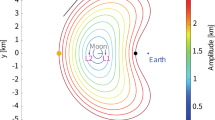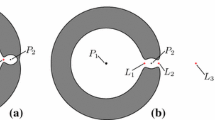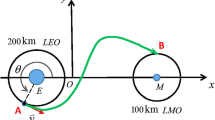Abstract
There exist cislunar and translunar libration points near the Moon, which are referred to as the LL 1 and LL 2 points, respectively. They can generate the different types of low-energy trajectories transferring from Earth to Moon. The time-dependent analytic model including the gravitational forces from the Sun, Earth, and Moon is employed to investigate the energy-minimal and practical transfer trajectories. However, different from the circular restricted three-body problem, the equivalent gravitational equilibria are defined according to the geometry of the instantaneous Hill boundary due to the gravitational perturbation from the Sun. The relationship between the altitudes of periapsis and eccentricities is achieved from the Poincaré mapping for all the captured lunar trajectories, which presents the statistical feature of the fuel cost and captured orbital elements rather than generating a specified Moon-captured segment. The minimum energy required by the captured trajectory on a lunar circular orbit is deduced in the spatial bi-circular model. The idea is presented that the asymptotical behaviors of invariant manifolds approaching to/traveling from the libration points or halo orbits are destroyed by the solar perturbation. In fact, the energy-minimal cislunar transfer trajectory is acquired by transiting the LL 1 point, while the energy-minimal translunar transfer trajectory is obtained by transiting the LL 2 point. Finally, the transfer opportunities for the practical trajectories that have escaped from the Earth and have been captured by the Moon are yielded by the transiting halo orbits near the LL 1 and LL 2 points, which can be used to generate the whole of the trajectories.





























Similar content being viewed by others
References
Andreu, M.A.: The quasi-bicircular problem. PhD thesis, Universitat de Barcelona (1999)
Belbruno, E., Miller, J.: Sun-perturbed Earth-to-Moon transfers with ballistic capture. J. Guid. Control Dyn. 16, 770–775 (1993)
Belbruno, E.: Capture Dynamics and Chaotic Motions in Celestial Mechanics. Princeton University Press, Princeton (2004)
Bollt, E.M., Meiss, J.D.: Targeting chaotic orbits to the Moon through recurrence. Phys. Lett. A 204, 373–378 (1995)
Circi, C., Teofilatto, P.: On the dynamics of weak stability boundary lunar transfers. Celest. Mech. Dyn. Astron. 79(1), 41–72 (2001)
Conley, C.: Low energy transit orbits in the restricted three-body problem. SIAM J. Appl. Math. 16, 732–746 (1968)
Conley, C.: On the ultimate behavior of orbits with respect to an unstable critical point. I. Oscillating, asymptotic, and capture orbits. J. Differ. Equ. 5, 136–158 (1969)
García, F., Gómez, G.: A note on weak stability boundaries. Celest. Mech. Dyn. Astron. 97, 87–100 (2007)
Koon, W.S., Lo, M.W., Marsden, J.E.: Low energy transfer to the Moon. Celest. Mech. Dyn. Astron. 81(1), 63–73 (2001)
Koon, W.S., Lo, M.W., Marsden, J.E., et al.: Dynamical Systems, the Three-Body Problem and Space Mission Design. Springer, New York (2007)
He, W., Xu, S.: Study on escaping energy in circular restricted three body problem. Acta Aeronaut. Astronaut. Sin. 28(2), 263–268 (2007)
Howell, K.C., Barden, B., Lo, M.W.: Application of dynamical systems theory to trajectory design for a libration point mission. J. Astronaut. Sci. 45, 161–178 (1997)
Howell, K.C., Beckman, M., Patterson, C., et al.: Representations of invariant manifolds for applications in three-body systems. J. Astronaut. Sci. 54(1), 69–93 (2006)
Macau, E.E.: Using chaos to guide a spacecraft to the Moon. In: 49th International Astronautical Congress, Australia (1998). IAF-98-A.3.05
Marsden, J.E., Ross, S.D.: New methods in celestial mechanics and mission design. Bull. Am. Math. Soc. 43, 43–73 (2006)
McGehee, R.P.: Some homoclinic orbits for the restricted 3-body problem. PhD thesis, University of Wisconsin (1969)
Mengali, G., Quarta, A.A.: Optimization of biimpulsive trajectories in the Earth–Moon restricted three-body system. J. Guid. Control Dyn. 28(2), 209–216 (2005)
Parker, J.S., Lo, M.W.: Shoot the Moon 3D. In: AAS/AIAA Astrodynamics Specialist Conference, Lake Tahoe (2005). AAS 05-383
Richardson, D.L.: Analytic construction of periodic orbits about the collinear points. Celest. Mech. 22(3), 241–253 (1980)
Ross, S.D., Koon, W.S.: Design of a multi-Moon orbiter. In: 13rd AAS AIAA Space Flight Mechanics Meeting, San Diego (2003). AAS03-143
Schroer, C.G., Ott, E.: Targeting in Hamilton systems that have mixed regular/Chaotic phase spaces. Chaos 7(4), 373–378 (1997)
Topputo, F., Vasile, M.: Earth-to-Moon low energy transfers targeting L 1 hyperbolic transit orbits. In: New Trends in Astrodynamics and Applications II, Princeton (2005)
Villac, B.F., Scheeres, D.J.: Escaping trajectories in the hill three body problem and applications. J. Guid. Control Dyn. 26(2), 224–232 (2002)
Xu, M., Xu, S.: Exploration of distant retrograde orbits around Moon. Acta Astronaut. 65(5–6), 853–860 (2009)
Xu, M., Tan, T., Xu, S.: Research on the transfers to Halo orbits from the view of invariant manifolds. Phys. Mech. Astron. 55(4), 671–683 (2012)
Xu, M., Wang, J., et al.: A new constellation configuration scheme for communicating architecture in cislunar space. Math. Probl. Eng. 19, 864950 (2013)
Xu, M., Xu, S.: Study on stationkeeping for Halo orbits at EL 1: dynamics modeling and controller designing. Trans. Jpn. Soc. Aeronaut. Space Sci. 55(5), 274–285 (2012)
Yagasaki, K.: Computation of low energy Earth-to-Moon transfers with moderate flight time. Physica D 197, 313–331 (2004)
Yamato, H.: Trajectory design methods for restricted problems of three bodies with perturbations. PhD thesis, Pennsylvania State University (2003)
Acknowledgements
The authors are very grateful to the anonymous reviewer for helpful comments and suggestions on revising the manuscript. The research is supported by the National Natural Science Foundation of China (11172020), the National High Technology Research and Development Program of China (863 Program: 2012AA120601), Talent Foundation supported by the Fundamental Research Funds for the Central Universities, Aerospace Science and Technology Innovation Foundation of China Aerospace Science Corporation, and Innovation Fund of China Academy of Space Technology.
Author information
Authors and Affiliations
Corresponding author
Rights and permissions
About this article
Cite this article
Xu, M., Wei, Y. & Xu, S. On the construction of low-energy cislunar and translunar transfers based on the libration points. Astrophys Space Sci 348, 65–88 (2013). https://doi.org/10.1007/s10509-013-1563-6
Received:
Accepted:
Published:
Issue Date:
DOI: https://doi.org/10.1007/s10509-013-1563-6




